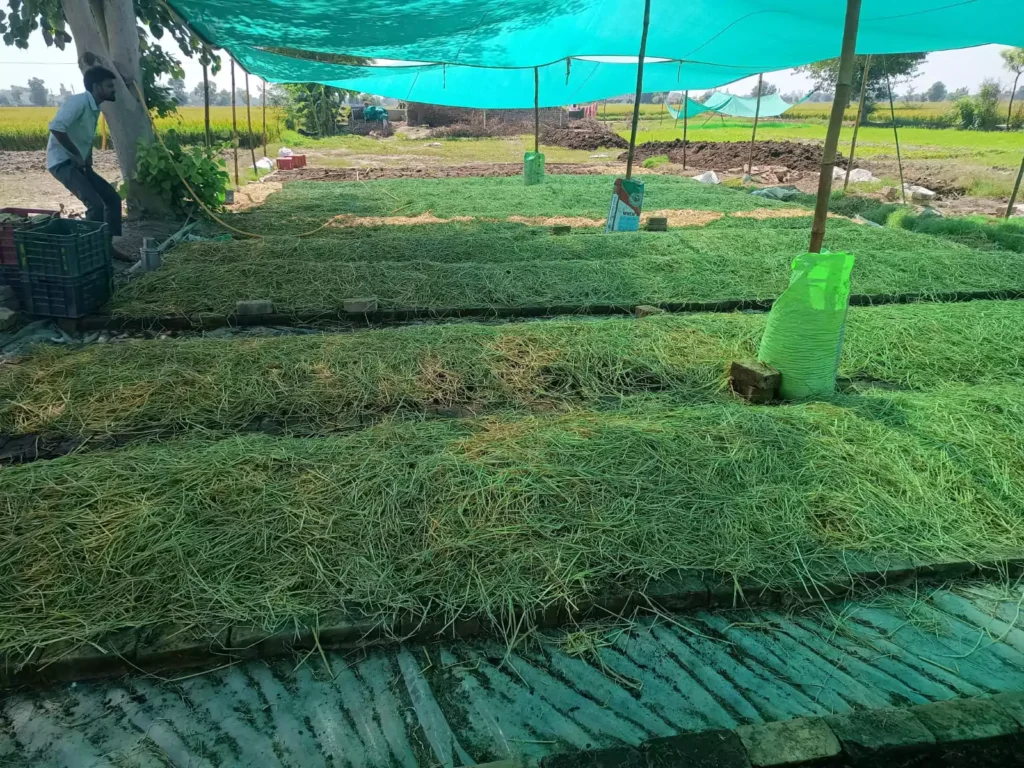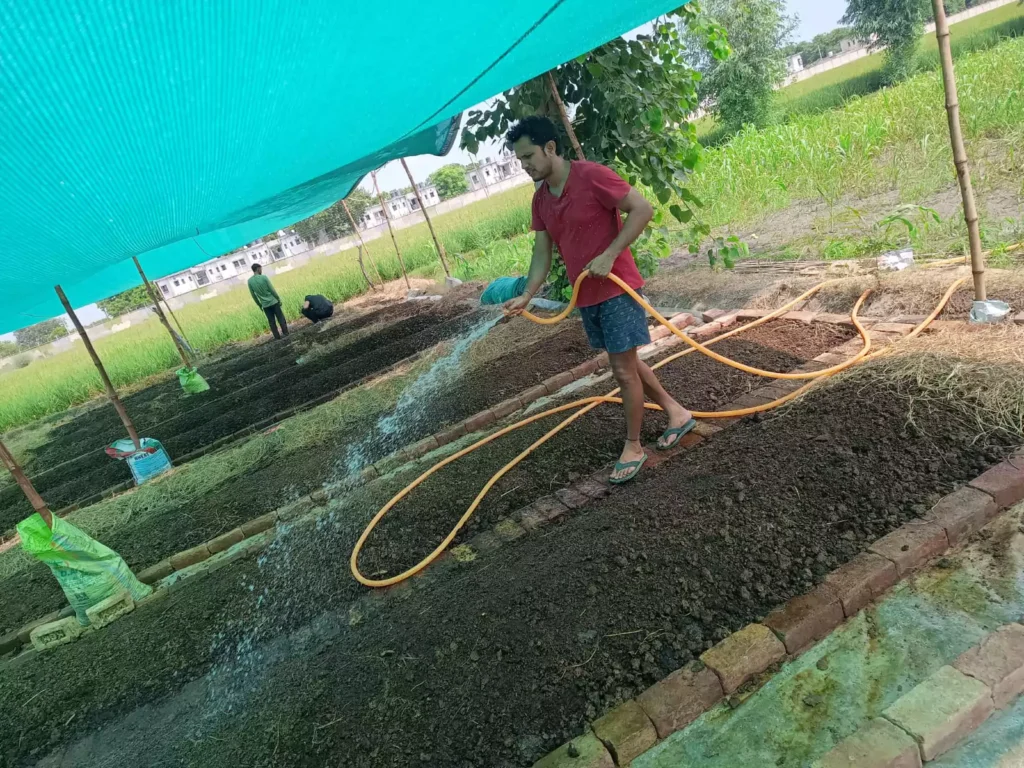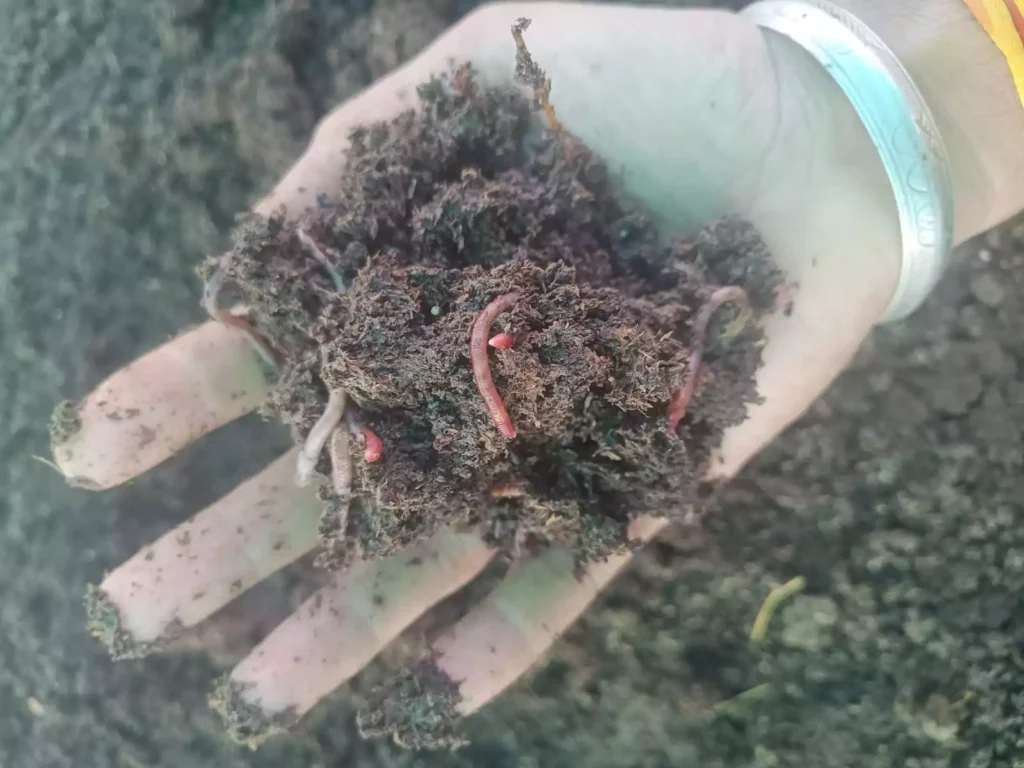What Is Vermicompost?

Vermicompost is a nutrient-rich, organic fertilizer and soil conditioner produced through the natural decomposition of organic waste by earthworms — most commonly, Eisenia fetida, also known as red wigglers. These little wriggly workers break down kitchen scraps, garden waste, and biodegradable matter into a dark, earthy-smelling material that’s fantastic for plants.
How Does Vermicomposting Work?
Worms eat organic matter like vegetable peels, leaves, coffee grounds, etc.
Their digestive systems break it down and enrich it with beneficial microbes.
The result? A crumbly, black, humus-like substance called vermicast (worm poop), which is the actual vermicompost.
Panchgavya (also spelled Panchagavya) is a traditional organic preparation used in Indian agriculture and Ayurveda. The word Panchgavya comes from Sanskrit, where:
“Panch” means five
“Gavya” means products obtained from cows
So, Panchgavya literally means “a mixture of five cow-derived products.”
Vermiwash is a liquid bio-fertilizer collected after water passes through a column of earthworm-rich compost. It contains enzymes, mucus, vitamins, and nutrients that promote plant growth, enhance soil microbes, and act as a natural pest repellent—perfect for organic farming.
Jeevamrit is a powerful organic liquid fertilizer made from cow dung, cow urine, jaggery, gram flour, and soil. Rich in beneficial microbes, it boosts soil fertility, promotes plant health, and enhances crop yield—an ideal natural tonic for sustainable and chemical-free farming.
Beeja Amrit is a traditional seed treatment solution made from cow dung, cow urine, lime, and a handful of soil. Used in organic farming, it protects seeds from fungal infections, enhances germination, and boosts early plant growth—ensuring healthy, chemical-free cultivation from the start.
Teekha Satt is a natural organic pesticide made from fermented cow urine, green chili, garlic, and neem leaves. It effectively repels harmful pests, protects crops, and supports eco-friendly farming. This powerful homemade bio-repellent is safe for plants, soil, and beneficial insects.
Dashparni Ark is a fermented organic pest repellent made from extracts of ten medicinal plants including neem, tulsi, and custard apple leaves. Rich in natural insecticidal properties, it helps control pests, improves crop health, and is widely used in organic and zero-budget natural farming.
Brahmastra is a potent organic pesticide prepared using cow urine, neem, dhatura, garlic, and other medicinal herbs. Fermented naturally, it helps eliminate leaf-eating insects, borers, and fungal issues. Widely used in organic farming, it protects crops while preserving soil and plant health.
Key Benefits of Vermicompost
Boosts Soil Fertility – Packed with nitrogen, phosphorus, potassium (NPK), and trace minerals.
Improves Soil Structure – Enhances aeration, moisture retention, and microbial activity.
Eco-Friendly – Reduces landfill waste and greenhouse gas emissions.
Cost-Effective – Homemade and sustainable for long-term use.
Safe for Plants – 100% organic and chemical-free.


Where Is Vermicompost Used?
🌿 Home Gardening
🌾 Organic Farming
🌸 Nurseries and Landscaping
🏫 Educational Projects
🌍 Waste Management Systems
🌿 Step-by-Step Vermicomposting Process
🪴 Step 1: Choose the Right Spot
Pick a cool, shaded, and well-ventilated area — indoors or outdoors. Avoid direct sunlight and heavy rain. It could be:
A balcony
Backyard
Garage
Shed
🧺 Step 2: Select or Build a Worm Bin
🪣 Options:
Plastic container with a lid (drilled with air holes)
Wooden box
Clay pot (for small-scale use)
Size Suggestion:
For kitchen waste: 60cm x 45cm x 30cm (L x W x H) is ideal
Tip: Add a tray or tap at the bottom for collecting worm tea (liquid fertilizer)!
🍂 Step 3: Add Bedding Material
Create a comfy bed for the worms. It should retain moisture and allow airflow.
Good Bedding Materials:
Shredded newspaper/cardboard
Dry leaves
Coco peat
Straw or hay
Moisten the bedding slightly — it should feel like a wrung-out sponge.
🐛 Step 4: Introduce the Earthworms
Use Eisenia fetida (red wigglers) – they’re composting champions!
Add around 500–1000 worms (for home use)
Spread them evenly on top of the bedding
Leave them for a day to settle in
🍎 Step 5: Add Organic Waste (Feed)
Start feeding your worms once they’ve settled (1–2 days later).
✅ Feed This:
Veggie & fruit peels
Tea bags & coffee grounds
Crushed eggshells
Banana peels
Cooked rice (plain & limited)
❌ Avoid:
Meat, fish, dairy
Citrus or spicy items
Oily food
Onion & garlic in large amounts
Plastics, glass, synthetic waste
Chop the waste into small pieces to speed up decomposition.
🔁 Step 6: Maintain & Monitor
Keep it Healthy:
Moisture: Keep it damp, not soaked
Turn Gently: Every 7–10 days to aerate
Odour: Should smell earthy — foul smell = too much food or moisture
Cover the bin with a jute sack or cardboard to keep pests away.
🧺 Step 7: Harvest the Vermicompost
When?
After 45–60 days, depending on conditions
Signs It’s Ready:
Black or dark brown
Crumbly texture
No foul smell
Little to no visible food left
How to Harvest:
Push compost to one side of the bin.
Add fresh food to the other side.
Worms will migrate to the new food.
Collect the compost after a few days.
You can also use light to drive worms down, then scoop the top compost
💧 Step 8: Collect Vermiwash (Optional)
If your bin has a drainage outlet:
Collect the liquid (vermiwash) in a bottle
Dilute 1:10 with water before spraying on plants
🌿 Step 9: Use the Compost
Mix the finished vermicompost into:
Potted plant soil
Vegetable gardens
Flower beds
Lawn topsoil
📝 Bonus Tips
Don’t overfeed worms — add small amounts every 2–3 days
Keep bin covered to avoid pests
Use multiple bins if composting at a larger scale
Worms reproduce! Your worm population will grow with time
🐛 Summary Table
| Step | Description |
|---|---|
| 1 | Choose a shaded location |
| 2 | Prepare bin with holes for airflow |
| 3 | Add moist bedding |
| 4 | Introduce red wigglers |
| 5 | Add organic waste (no meat/dairy) |
| 6 | Maintain moisture and turn weekly |
| 7 | Harvest compost after 45–60 days |
| 8 | Collect and use vermiwash (optional) |
| 9 | Apply compost to plants and soil |
FAQs About Vermicompost ❓
What is vermicompost?
Vermicompost is a nutrient-rich organic fertilizer produced by earthworms as they break down biodegradable waste materials like kitchen scraps, cow dung, and plant residues.
What are the benefits of using vermicompost?
Enhances soil fertility and texture
Boosts plant growth and yield
Improves water retention in soil
Contains beneficial microbes and enzymes
100% natural and chemical-free
How is vermicompost different from regular compost?
Unlike traditional compost, vermicompost is created using earthworms (especially Eisenia fetida) which accelerate decomposition and add extra nutrients like enzymes, growth promoters, and beneficial bacteria.
Can I use vermicompost for all plants?
Yes! Vermicompost is safe and effective for vegetables, flowers, indoor plants, fruit trees, lawns, and even potted plants.
How should I apply vermicompost to plants?
Mix into soil: 20–30% vermicompost with garden soil
As top dressing: Sprinkle around the plant base
In pots: Use 1–2 handfuls per plant every 15–30 days
By: Vermicomposts